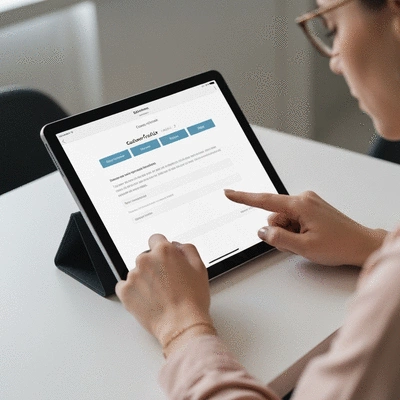What if a simple shift in understanding could transform your product's success? The 'usage gap' could be the key to unlocking deeper engagement and satisfaction for your users.
What You Will Learn
- The 'usage gap' highlights the discrepancy between expected and actual product engagement.
- Identifying the 'usage gap' is crucial for enhancing user experience and product satisfaction.
- Regularly collecting customer feedback helps teams pinpoint areas for improvement.
- Understanding user behavior is essential for tailoring effective engagement strategies.
- Closing the 'usage gap' can foster brand loyalty and increase market share.
Understanding the Product 'Usage Gap'
The 'usage gap' represents the difference between a product's expected usage and its actual engagement. Closing this gap is crucial for product success and user satisfaction.
Defining the Usage Gap
The 'usage gap' is the discrepancy between product expectations and actual usage, often revealed through:
- Low daily active users vs. sign-ups
- High churn rates early on
- Under-utilization of key features
Impact of Ignoring the Gap
Failing to address the usage gap can lead to significant issues for product teams, such as:
- Misallocated feature development resources
- Increased customer support inquiries
- Lower overall satisfaction and retention
Gathering Customer Feedback
Essential methods for understanding user pain points and preferences include:
- Conducting user interviews
- Running satisfaction and feature surveys
- Analyzing user behavior via heatmaps
Key Strategies for Improvement
To drive product success and user engagement, focus on these actionable steps:
- Regularly review engagement metrics
- Implement user training and resources
- Continuously iterate on features
Understanding the 'Usage Gap' in Product Engagement
The concept of the 'usage gap' is increasingly relevant in today’s fast-paced digital marketplace. Essentially, it refers to the difference between the expected usage of a product and its actual engagement levels. This gap can often hinder a product's success, leading to missed opportunities for both growth and customer satisfaction. So, what does it really mean for your product? Let’s dive in!
Understanding the 'usage gap' allows product teams to pinpoint areas where users may struggle or disengage. Recognizing this gap isn't just about numbers; it's about connecting with users and fostering a relationship that encourages ongoing interaction with your product. This concept is often discussed in relation to broader issues like the digital gap in public policy, where discrepancies in access and utilization can significantly impact societal outcomes.

Defining the 'Usage Gap': What It Means for Your Product
To define the 'usage gap', we first need to understand the metrics involved. It's often revealed through user analytics, surveys, and feedback that indicate discrepancies between product expectations and actual usage. This gap can manifest in several ways:
- Low daily active users compared to sign-up rates
- High churn rates within the first few weeks of engagement
- Under-utilization of key features and functionalities
When we talk about the 'usage gap', we're really looking at the disconnect between product design and user experience. A product may be perfectly built, but if it doesn’t resonate with users, engagement will inevitably falter. Understanding this gap is crucial for any business aiming to create lasting relationships with its customers. Research highlights the importance of user experience, as detailed in studies on the impact of user experience on product adoption.
Why Recognizing the 'Usage Gap' is Crucial for Product Teams
For product teams, recognizing the 'usage gap' isn’t just a matter of tracking metrics; it’s about strategically aligning products with user expectations. Ignoring this gap can lead to significant fallout, including:
- Misallocated resources on features that users don't want
- Increased customer support queries due to confusion
- Lower overall satisfaction and retention rates
By acknowledging the 'usage gap', teams can make informed decisions on where to focus their efforts, ensuring that features align more closely with user needs. This proactive approach not only enhances the product but also fosters a culture of continuous improvement. The significance of this proactive approach is further explored in academic discussions on balancing user needs and business goals in product development.
The Role of Customer Feedback in Identifying the 'Usage Gap'
Customer feedback is invaluable in recognizing the 'usage gap'. It offers insights that quantitative data simply can’t capture, allowing businesses to understand user pain points and preferences deeply. Here are a few effective ways to gather this feedback:
- Conducting user interviews to gain qualitative insights
- Running surveys to quantify user satisfaction and feature requests
- Analyzing user behavior through heatmaps and session recordings
Integrating customer feedback into the product development cycle not only helps identify the 'usage gap' but also builds trust. It shows users that their voices matter and that their experiences shape product decisions. As the founder of The Stone Builders Rejected, I believe that fostering this connection is key to creating products that truly resonate with users.
Exploring the Dynamics of Product Adoption and Usage
Delving into the intricacies of product adoption and usage reveals how these concepts are interconnected yet distinct. Understanding these dynamics is critical for overcoming the 'usage gap' effectively.
Pro Tip
To effectively bridge the 'usage gap', focus on user education. Providing comprehensive onboarding experiences and tutorials can empower users to fully utilize your product's features, significantly enhancing engagement levels and satisfaction.

Frequently Asked Questions about the 'Usage Gap'
- What is the 'usage gap'?
- The 'usage gap' is the discrepancy between a product's expected usage and its actual engagement levels, often including low active users, high churn rates, and under-utilized features.
- Why is it important for product teams to recognize the 'usage gap'?
- Recognizing the 'usage gap' helps product teams align their development efforts with user expectations, preventing misallocated resources, reducing customer support issues, and improving overall user satisfaction and retention.
- How can customer feedback help in identifying the 'usage gap'?
- Customer feedback, gathered through interviews, surveys, and behavior analysis (like heatmaps), provides qualitative and quantitative insights into user pain points and preferences, which are crucial for understanding why users might not be engaging with a product as expected.
- What are some strategies to close the 'usage gap'?
- Strategies include regularly reviewing engagement metrics, establishing a strong feedback loop with users, providing comprehensive user training and resources, and continuously iterating on product features based on user feedback and analytics.
- What are the benefits of closing the 'usage gap'?
- Closing the usage gap leads to enhanced user experience and satisfaction, fosters brand loyalty, increases market share, and ensures that product development efforts are aligned with actual user needs.
Summarizing the Importance of Closing the 'Usage Gap'
As we delve deeper into the nuances of product engagement, it’s vital to recognize the significance of closing the 'usage gap'. This gap not only impacts user retention but also reflects the overall health of your product's ecosystem. By understanding the factors contributing to this gap, product teams can tailor their strategies to foster stronger connections with users.
Ultimately, addressing the 'usage gap' means acknowledging the disconnect between what users are capable of utilizing and what they actually engage with. This realization can transform how we approach product development, support, and marketing, ensuring that we create solutions that truly resonate with our audience.
Key Takeaways for Product Teams and Stakeholders
- Identifying the 'usage gap' is essential for enhancing user experience and product satisfaction.
- Regularly collecting customer feedback allows teams to pinpoint specific areas for improvement.
- Understanding user behavior is crucial for tailoring effective engagement strategies.
- Adoption metrics offer valuable insights into user engagement and help measure success.
- Closing the gap fosters brand loyalty and can lead to increased market share.
By focusing on these key points, teams can pave the way for more effective product strategies that align with user needs. Remember, the goal is not just to attract users but to keep them engaged and satisfied over time!
Next Steps: Implementing Strategies for Improved Product Engagement
After recognizing the importance of addressing the 'usage gap', it’s time to take actionable steps. Implementing strategies for improved product engagement involves a structured approach that can evolve with user feedback and market trends. As the founder of The Stone Builders Rejected, I often find parallels between effective news reporting and product engagement; both rely on understanding the audience’s needs and adapting accordingly.
To kickstart this process, it's essential to build a robust framework that not only supports user adoption but also continuously evolves. Here are some steps that can lay the groundwork for success:
Building a Framework for Continuous Improvement in User Adoption
- Regularly review user engagement metrics to identify trends and gaps.
- Establish a feedback loop with users to understand their experiences and challenges.
- Implement training sessions and resources to empower users to maximize product utilization.
- Continuously iterate on product features based on user feedback and analytics.
This framework serves as a living document, guiding product teams to remain agile and responsive to user needs. By fostering a culture of continuous improvement, you’ll not only enhance user satisfaction but also drive greater product success!
Encouraging Ongoing Learning and Adaptation for Product Success
In today’s fast-paced digital landscape, the ability to learn and adapt is key. Encourage your team to embrace ongoing learning opportunities—both from user insights and industry trends. By doing so, you position your product to evolve with the changing market while meeting the needs of your users head-on.
Consider the following approaches:
- Participate in industry conferences to stay updated on the latest trends.
- Invest in training programs that focus on user psychology and behavior.
- Host regular brainstorming sessions to foster creativity and innovation.
As someone passionate about uncovering insights, I can attest that ongoing learning cultivates an environment where innovation thrives. This commitment to adaptation not only enhances product engagement but also empowers your team to navigate challenges effectively!
Aligning Marketing Strategies with User Feedback for Better Engagement
Marketing and product development should go hand in hand. By aligning marketing strategies with user feedback, product teams can create campaigns that genuinely resonate with their audience. This synergy is crucial for driving engagement and ensuring that users are aware of all the features your product has to offer.
Here are some strategies to consider:
- Leverage user testimonials and case studies in marketing materials to build trust.
- Utilize social media channels to gather real-time feedback and engage with users.
- Focus on content marketing that educates users about maximizing product features.
By incorporating user feedback into your marketing strategies, you’ll not only enhance engagement but also cultivate a community of loyal users who feel valued. This is the essence of creating lasting relationships with your audience! Let’s keep pushing the boundaries of what’s possible together!
Recap of Key Points
Here is a quick recap of the important points discussed in the article:
- Identifying the 'usage gap' is essential for enhancing user experience and product satisfaction.
- Regularly collecting customer feedback allows teams to pinpoint specific areas for improvement.
- Understanding user behavior is crucial for tailoring effective engagement strategies.
- Adoption metrics offer valuable insights into user engagement and help measure success.
- Closing the usage gap fosters brand loyalty and can lead to increased market share.






